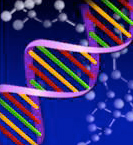Draft of Human Genome Finished

Draft of Human Genome Finished
|
An international team of scientists announced in London yesterday the completion of the blueprint of human life - a draft of the human genome.
Francis Collins, chief scientist of the Human Genome Project, which was launched in 1990, said before the announcement that they have completed a "working draft" of the human genome, which contains the genetic sequence of an estimated 90 per cent of the sequence arranged in near perfect order on a genetic map.
The Human Genome Project (HGP) involving 1,000 scientists from 16 institutions worldwide aims to sequence the 3 billion DNA base pairs that make up the human body.
US, British, Chinese, Japanese and French scientists co-operated on the HGP project. Chinese scientists were assigned by the international efforts to sequence 1 per cent of the human genome, said Yang Huanming, director of Human Genome Centre (HGC) under the Chinese Academy of Sciences, which participated in the research.
US president Bill Clinton and British Prime Minister Tony Blair officially announced the news in Washington yesterday.
Another private gene-sequencing company, US-based Celera Genomics, announced simultaneously that it has independently completed a working draft of the human genome.
Representatives from HGP and the Celera both attended the ceremony in Washington, in a rare show of reconciliation between the two rivals that had fiercely competed in the race to sequence the genome.
The US$3 billion-dollar HGP was started by the US government and has since developed into an international collaboration, Yang said. It is widely seen as one of history's greatest scientific milestones.
Sequences of DNA form the genes that make us what we are, govern our biological functions and determine our susceptibility to illnesses, Yang said.
The genetic blueprint of the human body is like a string of letters representing the four substances that make up every gene: adenine, thymine, guanine and cystosine.
Mapping the genome ushers in a new era of genetics-based medicine, enabling doctors to treat the underlying genetic causes of human illnesses, including heart disease and cancer.
The final "working draft" data is now being posted on the Internet at a rate of 10,000 DNA letters per minute from all the 16 institutions in six countries, including China's.
The non-profit consortium also announced that international efforts are now being focused on filling the remaining gaps in the DNA sequence and increase the overall accuracy to 99.99 per cent.
A finished map of the human genome is expected next year, to make what the consortium described as a "gold-standard reference" for the identification of hereditary diseases.
|